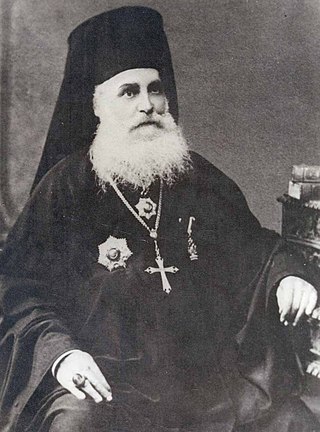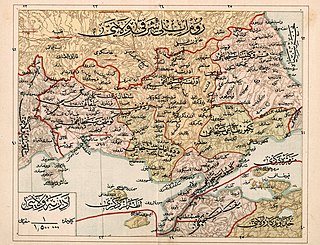
An exarch was the holder of any of various historical offices, some of them being political or military and others being ecclesiastical.

The Bulgarian Orthodox Church, legally the Patriarchate of Bulgaria, is an autocephalous Eastern Orthodox jurisdiction based in Bulgaria. It is the oldest Slavic Orthodox church, with some 6 million members in Bulgaria and between 1.5 and 2 million members in a number of other European countries, Asia, the Americas, Australia, and New Zealand. It was recognized as autocephalous in 1945 by the Ecumenical Patriarchate of Constantinople.

The Bulgarian Exarchate was the official name of the Bulgarian Orthodox Church before its autocephaly was recognized by the Ecumenical See in 1945 and the Bulgarian Patriarchate was restored in 1953.
The term Bulgarian Catholic Church can refer to:

The Catholic Church in Serbia is part of the worldwide Catholic Church in Serbia, under the spiritual leadership of the Pope in Rome. There are 356,957 Catholics in Serbia according to the 2011 census, which is roughly 5% of the population. Estimates in 2020 suggested that the figure had risen to 5.5-6%.

The Catholic Church in North Macedonia is part of the worldwide Catholic Church, under the spiritual leadership of the Pope in Rome and is one of the major religious communities that exist on the territory of the Republic of North Macedonia. Catholic believers from North Macedonia mostly include Albanians, Macedonians and Croats and are most concentrated in the Skopje Statistical Region and the Southeastern Statistical Region of North Macedonia.

The Bulgarian Greek Catholic Church is a sui iuris ("autonomous") Eastern Catholic church based in Bulgaria. As a particular church of the Catholic Church, it is in full communion with the Holy See. The Church's liturgical usage is that of the Byzantine Rite in the Bulgarian language. The Church is organised as a single eparchy — the Bulgarian Greek Catholic Eparchy of Sofia.

The Eparchy of Križevci is a Greek Catholic Church of Croatia and Serbia eparchy of the Catholic Church in Croatia, Slovenia, and Bosnia and Herzegovina. Its current eparch is Milan Stipić. The cathedra is in the Cathedral of the Holy Trinity, in the episcopal see of Križevci, Croatia.

Joseph Sokolsky was the first senior Eastern Orthodox Bulgarian clergyman to convert to Catholicism, thus becoming a pioneer of the Bulgarian Byzantine Catholic Church. Sokolsky negotiated with Vatican a formal union due to Phanariotes domination over Bulgarian Orthodoxy and gained Catholic recognition in 1861 when Pope Pius IX named him Archbishop for the Bulgarians of the Byzantine Rite. He was also accepted in that capacity by the Ottoman Empire.

In AD 1453, the city of Constantinople, the capital and last stronghold of the Byzantine Empire, fell to the Ottoman Empire. By this time Egypt had been under Muslim control for some seven centuries. Jerusalem had been conquered by the Rashidun Caliphate Muslims in 638, won back by Rome in 1099 under the First Crusade and then reconquered by Saladin's forces during the siege of Jerusalem in 1187. Later in the seventh Crusade, it was taken back by the Catholics once again. It was conquered by the Ottomans in 1517. Orthodoxy, however, was very strong in Russia which had recently acquired an autocephalous status; and thus Moscow called itself the Third Rome, as the cultural heir of Constantinople. Under Ottoman rule, the Greek Orthodox Church acquired power as an autonomous millet. The ecumenical patriarch was the religious and administrative ruler of the entire "Greek Orthodox nation", which encompassed all the Eastern Orthodox subjects of the Empire.

Raphael Popov was a Bulgarian Byzantine-Catholic bishop and one of the leaders of Bulgarian national revival. Originally he was an Eastern Orthodox deacon, but converted in 1860 to Catholic Church. In 1865, he became Administrator of the Bulgarian Byzantine Catholic Church in the Ottoman Empire and was ordained as bishop.

Lazar Mladenov was a Bulgarian Orthodox priest and, later, a member of the Bulgarian Uniat Church in the Ottoman Empire and a convert to Eastern Catholicism.

Nil Izvorov was a Bulgarian hierarch, activist of the Bulgarian National Revival and participant in the struggle for an independent Bulgarian Church. In 1874, as a bishop of the Orthodox Church he became Bulgarian Uniate and Apostolic Administrator of the Bulgarian Uniates in the Ottoman Empire. At the end of his life returned to the Orthodoxy.
Cyril Stephanov Kurtev was a Bulgarian Greek Catholic bishop.
Bishop Isaias Papadopoulos was the first Exarch of the Greek Byzantine Catholic Church.
The Greek Catholic Apostolic Exarchate of Constantinople is an Apostolic Exarchate of the Greek Byzantine Catholic Church which is an Eastern Catholic Church. As a sui iuris (autonomous) Church, it is in full communion with the Holy See. In its liturgical services it uses the Byzantine Rite in the Greek language. It is effectively defunct.

The Bulgarian Catholic Eparchy of Saint John XXIII of Sofia is an eparchy of the Bulgarian Greek Catholic Church which is a sui iuris ("autonomous") Eastern Catholic church based in Bulgaria. As a particular church of the Catholic Church, it is in full communion with the Holy See. The Church is organised as a single eparchy. Its liturgical usage is that of the Byzantine Rite in the Bulgarian language. It was elevated from an Apostolic Exarchate to a full eparchy by Pope Francis on 12 October 2019. The cathedral church of the eparchy is the Cathedral of the Dormition, in Bulgaria's capital Sofia. The incumbent eparch is Christo Proykov.

The Bulgarian Catholic Apostolic Vicariate of Tracia was the second missionary, pre-diocesan jurisdiction of the Bulgarian Greek Catholic Church sui iuris.

The Macedonian Apostolic Vicariate of the Bulgarians, informally Macedonia of the Bulgarians, was one of the missionary, pre-diocesan jurisdiction of the Bulgarian Greek Catholic Church sui iuris.















